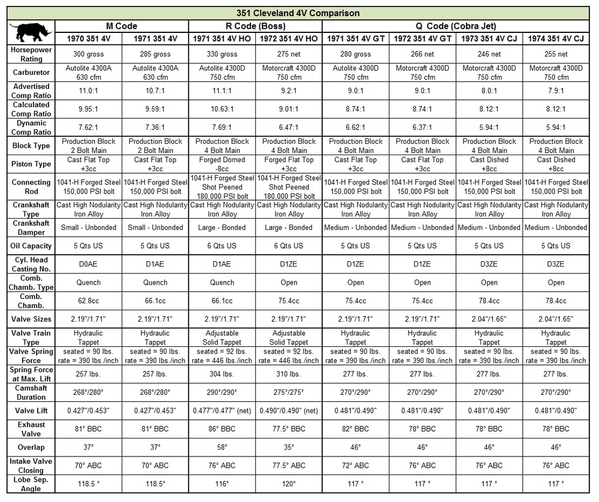they are different engines, different cams, carbs, heads, pistons in some cases .... here's an article written by Tom Custom,
The Q code engine package was introduced in 1971 as a performance version of the 351C. Here are the different versions of the US 351C
1970:
H code: 351C-2V, two barrel engine, 9:1 CR, open 2V style heads
M code: 351C-4V four barrel engine, 10.7:1 CR, closed 4V style heads
The M code used a small cam. It was powerful, but not a performance engine. That is, it didn't have any race parts. Both engine used positive lock rockers and flat top pistons.
1971:
H code: 351C-2V, two barrel engine, 9:1 CR, open 2V style heads
M code: 351C-4V four barrel engine, 10.5:1 CR, closed 4V style heads
Q code: Cobra Jet 4V 9:1 CR four barrel engine. Had special parts like high lift cam (same profile as 428CJ), dual point ignition with 4 speed, larger harmonic balancer, baffled oil pan, four bolt mains, big spread bore carb. This engine used open 4V style heads with positive lock rockers. Lower cost, easy maintenance, regular gas performance engine.
R code: (BOSS351) Boss four barrel engine, 11.7:1 CR, closed 4V style heads with adjustable rockers, forged pistons, high strength rod bolts, crank selected for a minimum hardness, solid lifter cam, large balancer, four bolt mains, dual point ignition, special exhaust manifolds (not that you could tell by the outside), baffled oil pan, aluminum intake and big spread bore carb. This was a serious performance engine package.
1972:
H code: 351C-2V, two barrel engine, 8.5:1 CR (or so), open 2V style heads
Q code: Cobra Jet 4V 8.5:1 CR (or so) four barrel engine. Same as 1971 but with dished pistons.
R code: HO four barrel engine, 9.5:1 CR, open 4V style heads with adjustable rockers, forged pistons, high strength rod bolts, crank selected for a minimum hardness, solid lifter cam (slightly different than the Boss), large balancer, four bolt mains, dual point ignition, special exhaust manifolds (not that you could tell by the outside), baffled oil pan, aluminum intake and big spread bore carb. This was a serious performance engine package, and a low compression version of the Boss.
1973:
H code: 351C-2V, two barrel engine, 8:1 CR (or so), open 2V style heads
Q code: Cobra Jet 4V 8:1 CR (or so) four barrel engine. Same as 1972 but got the 2V sized valves in the 4V heads. Cam was retarded in timing 4 degrees sometime starting in 1972. The change is in the cam. It gets an EGR system. Only 4V Cleveland engine option in 1973/74.
The 1973 Q code used a special air cleaner housing with the usual snorkel on the right side, a second air inlet controlled by a vacuum servo on the left (US driver's) side, and a chrome lid. Transmissions with the CJ were either the Toploader (only close ratio available in 1973) or the C6 with a special smaller diameter, high stall torque converter. Dual points only with 4 speed. All CJ years cam with a cast iron spread bore intake manifold
1974:
Q Code Same as 1973. No 4 speed option so no dual points for Q code. Last year for the 351C. In 1975, the taller deck 400 would used with a destroked crank and different pistons to make the 351M. The 400 continued with the 351M until 1980?
http://351c.net/board/index.ph...leveland-tom-custom/
========================================================
and George's comparison chart contains multitudes of info
========================================================
but the most important thing is the complete picture of how the mechanical advance rates and limits are set. the 6* initial distributor will allow more total advance within the mechanism before the breaker plate reaches the stop limit while the 16* distributor will allow less travel so it doesn't allow excessive total timing. they end in total advance very close to / if not the same point but everything from the start to in between is different. you shouldn't arbitrarily crank a 6* initial dizzy up to 16* and think you licked it, you just dialed in 10 excessive total timing degrees! the 6* dizzy needs to be 'recurved' to limit the travel of the breaker plate to control total timing. very good tutorial here, 2 pages ![]()
http://www.reincarnation-autom...tructions_index.html
for more reference look at Mustang tune-up specs for the various years, Pantera engines were sourced from the Mustang assy line queue or built to same spec



